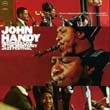Reviews One of The Unsung Greats of Modern Jazz One of The Unsung Greats of Modern Jazz
John Handy is one of the unsung greats of modern jazz -- as saxophonist, composer/arranger and group leader -- especially for the series of four albums he recorded for Columbia between 1965 and 1968. This Mosaic Select is devoted to the three albums he made for the label that featured violin in the instrumentation -- Recorded Live At The Monterey Jazz Festival, The 2nd John Handy Album and Projections, plus a live Carnegie Hall performance. Handy's playing, on alto sax in particular, is a wonder with a beautiful "legit" sound, perfect intonation and articulation, and an extraordinary control of the upper register which he uses quite often in building excitement and intensity in his solos. He utilizes all of these extraordinary attributes in frequent lengthy and compelling acappella solos. His unending flow of fresh ideas seemingly devoid of licks is another striking characteristic of his work. The group heard here on all of discs 1 and 2 is unique in jazz history. The instrumentation of alto saxophone, violin, guitar, bass and drums has rarely, if ever, been used, and certainly not to this extent. Combining the nature of this instrumentation with the styles of the five players (Handy, Michael White, Jerry Hahn, Don Thompson and Terry Clarke) helps to create an open, expansive musical palette. This enables a musical range from Coltranesque long trance-like modal pieces, to tauter more direct and edgier rock-oriented pieces.
After playing with Charles Mingus at the Monterey Jazz Festival's historic session in 1964, Handy went to Vancouver, B.C., and met two Canadian musicians, bassist Don Thompson and drummer Terry Clarke. On his return, he told everyone about them and how he hoped to bring them to San Francisco. Eventually, it worked out and eventually the group opened at the Both/And. I was not there on the opening night; I didn't get there for a couple of weeks, and people kept telling me that I was missing something. Finally, one night I decided to make a tour of the Divisadero Street section, which is becoming a new jazz area in San Francisco. I stopped at the Half Note, run by Herbert and Norma Warren who used to operate Sugar Hill in North Beach. Thus, I eventually got to the Both/And, in the company of Herbert, a rival nightclub owner, to hear John Handy. There was almost no one in the club, but the band was on stage and the Canadians were there, and so was Mike White, a violinist who had long had an underground reputation as an exciting soloist, and pianist Freddie Redd, once again in a period of San Francisco residence. They started to play. I was stunned within moments. I simply couldn't believe it. The power and excitement which flowed from that band was overwhelming. I looked at Herbert Warren and he looked at me, and we shook our heads in disbelief. It was one of the great moments of a lifetime of listening to jazz. So I wrote a column about it in the San Francisco Chronicle, a column filled with exuberance, hoping to reflect some of my own excitement at the band's performance. Some weeks later, on the San Francisco educational television station, KQED, we did a Jazz Casual show (which one day I hope will play on the rest of the National Educational Television Network). We made a tape of that show, and I wrote a note to John Hammond at Columbia Records to tell him I was sending it to him. I don't know if this is ethical for a jazz critic, but I couldn't keep from screaming about this band. Hammond expressed immediate and firm interest. Soon, we took Jimmy Lyons, general manager of the Monterey Jazz Festival, out to the Both/And. He, too, was knocked out by John Handy's group and signed them to appear at the 1965 Monterey Jazz Festival on the afternoon avant-garde program. At Monterey, before an arena packed with 7,000 people sitting in the blazing sun, John Handy turned the band loose (guitarist Jerry Hahn had replaced Freddie Redd by then) and broke it up. They played two numbers - the performances in this album - and they were the hit of the Festival. People gave Handy a standing ovation and talked about what they had heard for weeks. They are still talking about it. I get calls every week asking when "the Monterey performance" will be released. These unexpected delights, these sudden enlightenments are what those of us who listen to jazz as a way of life live for. More Reviews:
|
 THE 1965 MONTEREY JAZZ FESTIVAL
THE 1965 MONTEREY JAZZ FESTIVAL